|
Medals and Ribbons
Nurses received more than 1,500 medals, citations,
and commendations during the war. Sixteen medals were awarded posthumously
to nurses who died as a result of enemy fire. These included the 6 nurses
who died at Anzio, 6 who died when the Hospital Ship Comfort was attacked
by a Japanese suicide plane, and 4 flight nurses. Thirteen other flight
nurses died in weather-related crashes while on duty. Overall, 201 nurses
died while serving in the Army during the war.
Service and Campaign Medals
Below is a list of decorations that Army Nurses
could receive for their service generally and for service in campaigns
during WWII.
.
American Defense Service
Medal

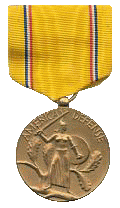
|
.. |
The American Defense Medal was awarded
to all military personnel including nurses, for honorable service of twelve
months or longer, at any time between September 8, 1939 and December 7,
1941.
The American Defense Service Medal was established
per Executive Order 8808 in June 1941 by President Franklin D. Roosevelt.
In February 1942, the criteria were announced in Department of the Army
Circular 44. The Secretary of War and the Secretary of Navy approved the
ribbon design in January 1942.
The golden yellow color was symbolic of the golden
opportunity of the youth of the United States to serve their country. The
blue, white and red pin stripes on each side represented the National
colors. |
| . |
|
|
American Campaign Medal

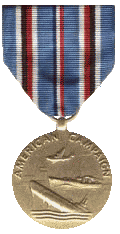
|
|
Awarded for service within the American Theater
from 7 December 1941 past the end of World War II. The American Campaign
Medal was established per Executive Order 9265, dated 6 November 1942,
by President Franklin D. Roosevelt. The American Campaig Medal was first
issued as ribbon only.
The ribbon design was approved by the Secretary
of War on 24 November 1942. The blue color represents America.
The blue, white and red stripes in the center
(taken from the American Defense Service Medal ribbon) refers to the continuance
of American defense after Pearl Harbor. The white and black stripes refer
to the German flag colors (the enemy at the Atlantic Coast) while red and
white stripes are for the Japanese colors and refer to that part of the
conflict on the Pacific Coast.
The American Theater included North America,
the Caribbean and certain Atlantic and Pacific islands and South America.
The service had to last at least a period of 30 consecutive days or 60
nonconsecutive days.
On 17 December 1947, the first medal was presented
to General of the Army George C. Marshall. |
| . |
|
|
Asiatic-Pacific Campaign
Medal

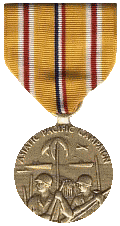
|
|
Alwarded for service within the Asiatic-Pacific
Theater from 7 December 1941 past the end of World War II. The Asiatic-Pacific
Campaig Medal was established per Executive Order 9265 in November 1942
by President Franklin D. Roosevelt.
The ribbon design was approved by the Secretary
of War on 24 November 1942. The white and red stripes on each side
represent the Japanese colors. The blue, white and red stripes in the center
are adopted from the American Defense Service Medal ribbon and refer to
the continuance of American Defense after Pearl Harbor. The medal was first
issued as ribbon only.
The Asiatic-Pacific Theater included Hawaii and
other Pacific Ocean islands, Alaska, Philippines, Australia, New Zealand,
Indonesia, New Guinea and southeast and south Asia as well as the eastern
Soviet Union. The service had to last at least a period of 30 consecutive
days or 60 nonconsecutive days. On 17 December 1947, the first medal was
presented to General of the Army Douglas MacArthur. |
| . |
|
|
European-African-Middle
Eastern Campaign Medal

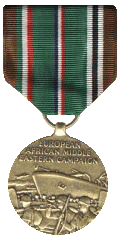
|
|
Awarded for service within the European-African-Middle
Eastern Theater from 7 December 1941 past the end of World War II.
The EAME Campaign Medal was established per Executive
Order 9265 in November 1942 by President Franklin D. Roosevelt. The medal
was first issued as ribbon only.
In December 1942, the ribbon design was approved
by the Secretary of War. The brown represents the sands of Africa and the
green represents the green fields of Europe. The blue, white, and red stripes
in the center are taken from the American Defense Service Medal ribbon
and refer to the continuance of American Defense after Pearl Harbor. Green,
white and red are the Italian colors and the white and black colors represent
Germany.
The European-African-Middle Eastern (EAME) Theater
included Europe, the western Soviet Union, Greenland, Iceland, Africa,
and southwest Asia. The service had to last at least a period of 30 consecutive
days or 60 nonconsecutive days. On 24 July 1947, General Eisenhower was
presented the first medal. |
| . |
|
|
WWII Victory Medal

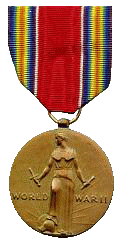
|
|
Awarded to all military personnel
for service between 7 December 1941 and 31 December 1946. The World War
II Victory Medal was established by an Act of Congress on 6 July 1945 (Public
Law 135, 79th Congress).
The specified ending date on December 31, 1946
was the date of the official termination of hostilities as proclaimed by
President Truman.
The Victory Medal was first issued as a ribbon,
and was referred to simply as the "Victory Ribbon".
By 1946, a full medal had been established which
was referred to as the World War II Victory Medal. |
| . |
|
|
Army of Occupation Medal

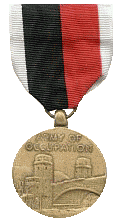
|
|
Awarded for 30 days consecutive service
or more while performing duty in Germany, Austria, Italy, Japan and Korea
at the close of World War II and postwar periods. Exact dates should be
referenced using official Army regulations.
The Army Occupation Medal was established by
War Department Circular 102 in April 1946.
The black color on the ribbon represented Germany,
the color red Japan. A Bronze clasp with the word "GERMANY" or "JAPAN"
ass worn on the suspension ribbon to indicate service in Europe or the
Far East.
The first medal was presented to General Eisenhower
on 2 April 1947. |
.
.
[
I. Development ]..[
II. Facts about the ANC ]..[
III. Uniforms ]..[IV.
Sources ]
|
